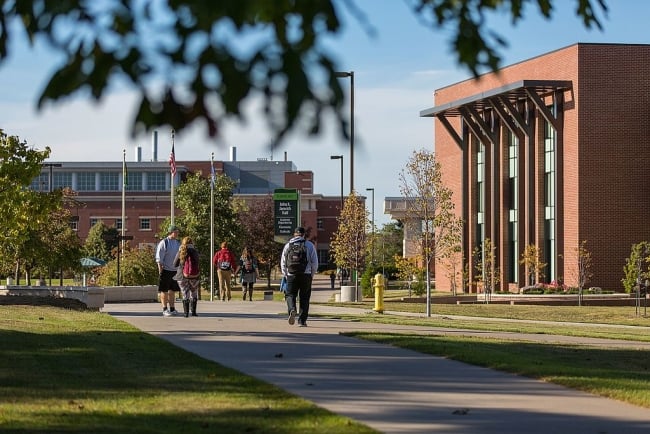You have /5 articles left.
Sign up for a free account or log in.

Northern Michigan University is one of many universities that is an anchor for its community.
Kpotes/Wikimedia Commons
Public colleges and universities do more than just educate students: Northern Michigan University created a wireless LTE network that brings affordable, high-speed internet service to Michigan’s sparsely populated Upper Peninsula. The University of North Carolina at Pembroke used CARES Act dollars to vaccinate members of the Lumbee Tribe against COVID-19. Research from the University of Michigan at Flint helped the city of Flint respond to a major lead contamination of its drinking water.
These are just some examples of the value of regional public institutions to the communities where they are located, a new report from the Brookings Institution argues.
The report, released today, suggests that the federal government should invest millions in regional and rural public colleges and universities to help them -- and surrounding communities -- recover from the economic effects of the COVID-19 pandemic.
Providing federal assistance to communities is essential to their recovery from the pandemic, said Robert Maxim, a senior research associate at Brookings and co-author of the report.
“But at the end of the day, you really need on-the-ground partners to be conduits for that investment,” he said. Public regional colleges are “the ultimate types of anchor institutions for implementing that.”
Such investment would take the form of $25 to $50 million grants, paid out over five years -- at a cost of $1.41 billion per year -- to nearly 150 regional public institutions “situated in distressed communities to support those schools’ economic and community development missions,” the report states.
Accredited public four-year colleges and universities would qualify as “distressed community-serving institutions" and be eligible for funding if they have a physical campus in the United states or surrounding territories and are located within a distressed community or within a county that has Native American tribal land. The authors listed 141 potentially eligible institutions to start with, including the University of North Alabama, Clayton State University in Georgia, Wichita State University in Kansas, the University of Minnesota at Morris and the University of Puerto Rico at Cayey. (This paragraph has been updated to reflect the location of Wichita State University.)
The report says many land-grant universities and large research institutions should be excluded, and so should federal service academies and state military or maritime colleges.
Kevin McClure, an associate professor of higher education at the University of North Carolina at Wilmington and co-founder of the Alliance for Research on Regional Colleges, supports the report’s policy recommendation.
“There is a growing stratification geographically where you’ve got some communities that are thriving and other communities that are getting left behind,” McClure said. “Oftentimes, conversations about how to address that issue don’t include the fact that you’ve got anchor institutions like colleges that can play a really significant role in supporting distressed communities.”
The report proposes that the grants be doled out in two parts: a small planning grant of up to $100,000, which would allow eligible institutions to design a project that would support economic and community development, and a larger multiyear implementation grant totaling between $25 million and $50 million and split among several community development projects.
By comparison, in fiscal year 2019, the federal government appropriated nearly $1.5 billion to support land-grant universities and nearly $45 billion to higher education institutions for research and development.
The federal government has historically focused its support on large, flagship research institutions, according to Maxim. He pointed to federally controlled land given to states to establish and endow flagship universities in the 1800s and 1900s. He also noted federal research funding provided to these universities throughout the 20th century, particularly during the Cold War.
“There’s kind of been this unquestioned idea that big land-grant and research universities have a level of federal support and that there’s a national interest in that,” Maxim said. “On the other side of the coin, though, there’s no involvement whatsoever with other public four-year universities. It’s been in the purview of the states.”
There is some precedent for federal investment in regional, public four-year colleges. The Strengthening Institutions Program was designed to support colleges and universities that have low educational and general expenditures and that enroll lots of low-income students. Part of the 1965 Higher Education Act was also established to provide grants to rural-serving institutions, but that section has never been funded by Congress.
Some institutions with other federal designations -- such as historically Black colleges and universities, Hispanic-serving institutions, tribal colleges and universities, and Native American-serving nontribal institutions -- receive federal support. But the federal programs that support those designated institutions don’t have economic and community development missions. What’s more, those designations leave out a number of institutions that serve critical roles in their communities.
Mildred García, president of the American Association of State Colleges and Universities, said her organization is pleased that the report sheds light on the importance of regional colleges and universities.
“It highlights some of the challenges that these under-resourced colleges and universities face in service to their communities and regions,” García said in a written statement. “AASCU supports efforts to bring additional funding to help these stewards of place fulfill their mission to provide access, retention, and success to the new majority of America and higher ed (the first generation, low income, and students of color).”
Questions about an institutions’ value often come up when a college is forced to close, merge or seek a buyer. Some higher education financial experts argue that struggling colleges aren’t worth investing in because they aren’t financially sustainable.
Maxim pushed back against this idea. He believes regional public colleges -- many of which have experienced enrollment, revenue and state funding declines in recent years -- are essential anchor institutions for their communities and should be supported despite having operating deficits.
“The idea that a typical public high school in America would need to profit would sound pretty absurd to some people,” Maxim said. “And so it’s funny when all of the sudden you get back to the higher ed discussion -- that if a school isn’t entirely self-sustaining or running at a profit, then they don’t deserve to exist.”
Maxim hopes members of Congress and Department of Education officials will seriously consider the report’s proposal.
“We’re really hoping that not only Congress and members with institutions in their districts will take an interest, but also that local leaders and state leaders as well,” he said.








